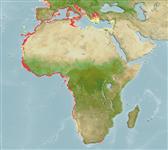Classificação / Names
Common names from other countries
Referência principal
Tamanho / Peso / Idade
Max length : 50.0 cm SL macho/indeterminado; (Ref. 6561); common length : 40.0 cm TL macho/indeterminado; (Ref. 26999)
Ambiente
; marinhas bentopelágico; intervalo de profundidade 10 - 70 m (Ref. 2683)
Clima / Intervalo
Subtropical, preferred 24°C (Ref. 107945); 48°N - 34°S, 18°W - 36°E
Distribuição
Descrição suscinta
Raios dorsais (total): 42-50; Raios anais : 33 - 38. Blue to brownish in color and darker spots dorsally, silver to whitish ventrally; juveniles with vertical bars on body and small black pelvic fins (Ref. 4410).
Status na Lista Vermelha da IUCN (Ref. 115185)
Perigo para os humanos
Harmless
Uso pelos humanos
Pescarias: pouco comercial
Mais informação
ReferênciasAquaculturaPerfil para aquaculturaEstirpesGenéticaFrequência alélicaHereditariedadeDoençasProcessamentoMass conversion
ColaboradoresFotosStamps, CoinsSonsCiguateraVelocidadeTipo de nataçãoÁrea branquialOtólitosCérebrosVisão
Ferramentas
Relatórios especiais
Baixar XML
Fontes da internet
Estimates of some properties based on models
Phylogenetic diversity index
PD50 = 0.6250 many relatives (e.g. carps) 0.5 - 2.0 few relatives (e.g. lungfishes)
Nível Trófico
4.0 ±0.50 se; Based on food items.
Resiliência
Médio, tempo mínimo de duplicação da população 1,4 - 4,4 anos (Assuming tm=2-3)
Vulnerabilidade
Low to moderate vulnerability (33 of 100)
Categoria de preço
